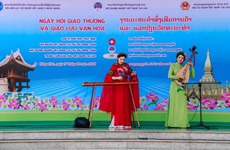Capital city’s names through historical periods
The capital city of Hanoi has its names changed many times during its thousand-year history.
The capital city of Hanoi has its names changed many times during its thousand-year history.
In 179 BC, Au Lac Kingdom was annexed by the Han aggressors, which ushered in
an over 1,000-year Chinese domination. By the middle of the fifth century, in the
centre of ancient Hanoi, the Chinese rulers set up a new district to serve as the headquarters of their regime and named it Tong Binh. By the year 679, the Tang
dynasty replaced the Sui dynasty and changed the country’s name to An Nam with
Tong Binh as the capital.
In 866, the Chinese Governor, Gao Pian, built a citadel in Tong Binh and named it
Dai La. Legend has it that while building the Dai La citadel, Cao Bien saw a divine
man appear and call himself Long Do. Therefore many books also referred to Dai La
citadel as Long Do.
The name of Dai La was then used until 1010 when a major change occurred in the city’s history.
According to the Dai Viet Historian Records, in the autumn of 1010, King Ly Cong Uan travelled to Dai La citadel. As his boat anchored at the area, the King saw a golden dragon flying onto the sky so he decided to move the capital to Dai La and changed the citadel’s name to Thang Long (Ascending Dragon).
By the end of the 14 th century, the De Dynasty weakened. Ho Quy Ly usurped the throne and moved the capital to Thanh Hoa called Tay Do (the capital in the west). The old capital Thang Long was renamed Dong Do (the capital in the east).
The Ho Dynasty then suffered defeat at the hand of Ming invaders in 1408, who then called the old capital city Dong Quan, meaning China’s eastern gate.
One century later, Le Loi defeated the northern aggressors and gave back to Thang
Long the capital status with the name of Dong Kinh.
In the Tay Son dynasty between 1787-1802, King Nguyen Hue (Quang Trung) set up
the capital in Phu Xuan (now Hue city in the central region) and called the old capital city in the north Bac Thanh (northern city).
At the beginning of the 19 th century, King Gia Long of the Nguyen Dynasty decided
to return to Phu Xuan and reinstated the city as the capital. As the result, in 1805, he changed the writing of Thang Long in pictographic letters from “rising dragon” to “rising prosperity” as dragon was the symbol of the King.
In 1831, King Minh Mang merged Thang Long city with some nearby towns and districts to establish Hanoi province and since then the Vietnamese capital city took
the name of Hanoi.
Thang Long-Hanoi has also had several unofficial names like Truong An (Trang An), Phuong Thanh (Phung Thanh), Long Bien, Long Thanh and Ha Thanh./.
In 179 BC, Au Lac Kingdom was annexed by the Han aggressors, which ushered in
an over 1,000-year Chinese domination. By the middle of the fifth century, in the
centre of ancient Hanoi, the Chinese rulers set up a new district to serve as the headquarters of their regime and named it Tong Binh. By the year 679, the Tang
dynasty replaced the Sui dynasty and changed the country’s name to An Nam with
Tong Binh as the capital.
In 866, the Chinese Governor, Gao Pian, built a citadel in Tong Binh and named it
Dai La. Legend has it that while building the Dai La citadel, Cao Bien saw a divine
man appear and call himself Long Do. Therefore many books also referred to Dai La
citadel as Long Do.
The name of Dai La was then used until 1010 when a major change occurred in the city’s history.
According to the Dai Viet Historian Records, in the autumn of 1010, King Ly Cong Uan travelled to Dai La citadel. As his boat anchored at the area, the King saw a golden dragon flying onto the sky so he decided to move the capital to Dai La and changed the citadel’s name to Thang Long (Ascending Dragon).
By the end of the 14 th century, the De Dynasty weakened. Ho Quy Ly usurped the throne and moved the capital to Thanh Hoa called Tay Do (the capital in the west). The old capital Thang Long was renamed Dong Do (the capital in the east).
The Ho Dynasty then suffered defeat at the hand of Ming invaders in 1408, who then called the old capital city Dong Quan, meaning China’s eastern gate.
One century later, Le Loi defeated the northern aggressors and gave back to Thang
Long the capital status with the name of Dong Kinh.
In the Tay Son dynasty between 1787-1802, King Nguyen Hue (Quang Trung) set up
the capital in Phu Xuan (now Hue city in the central region) and called the old capital city in the north Bac Thanh (northern city).
At the beginning of the 19 th century, King Gia Long of the Nguyen Dynasty decided
to return to Phu Xuan and reinstated the city as the capital. As the result, in 1805, he changed the writing of Thang Long in pictographic letters from “rising dragon” to “rising prosperity” as dragon was the symbol of the King.
In 1831, King Minh Mang merged Thang Long city with some nearby towns and districts to establish Hanoi province and since then the Vietnamese capital city took
the name of Hanoi.
Thang Long-Hanoi has also had several unofficial names like Truong An (Trang An), Phuong Thanh (Phung Thanh), Long Bien, Long Thanh and Ha Thanh./.













